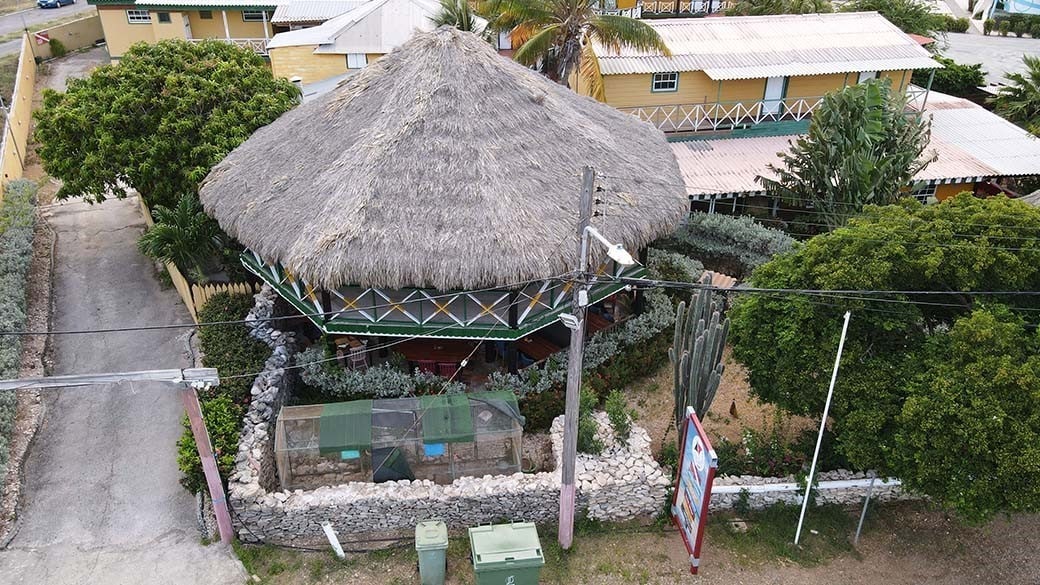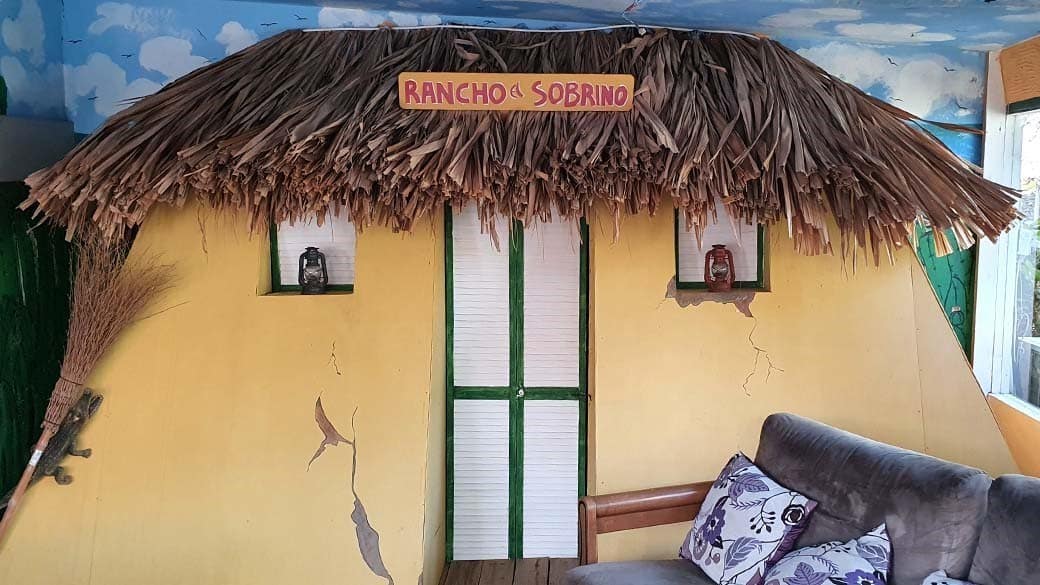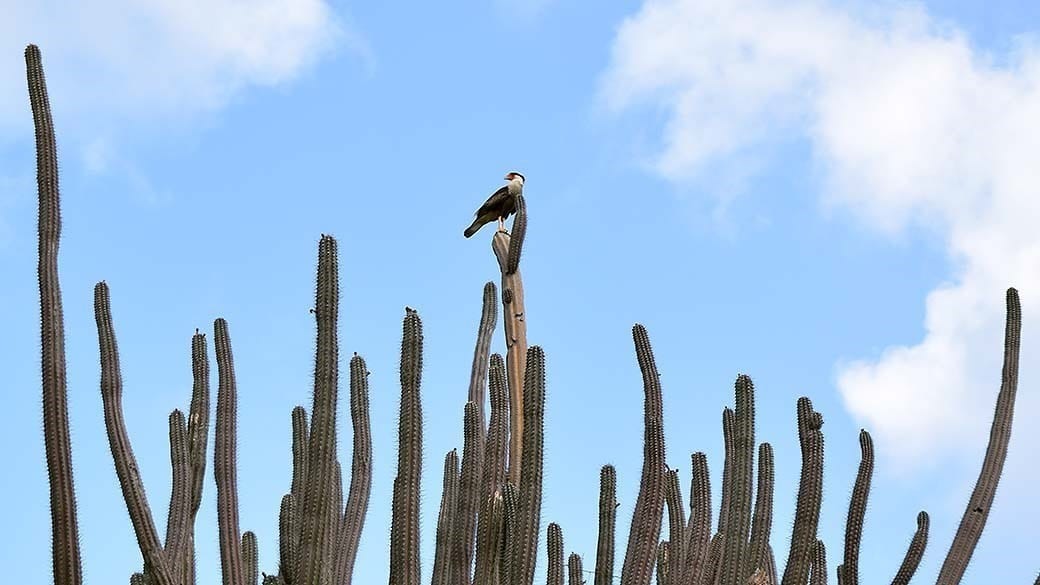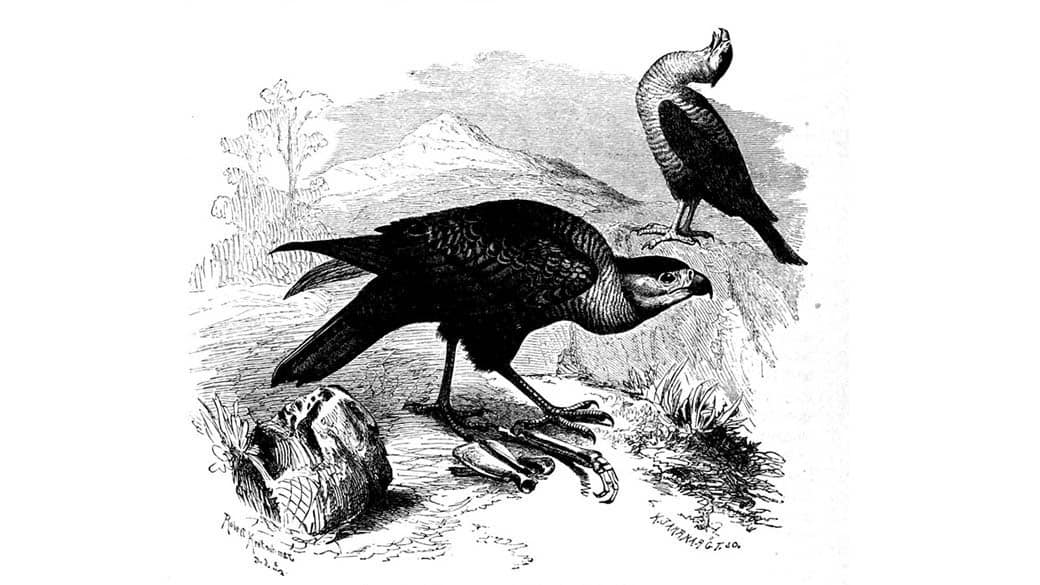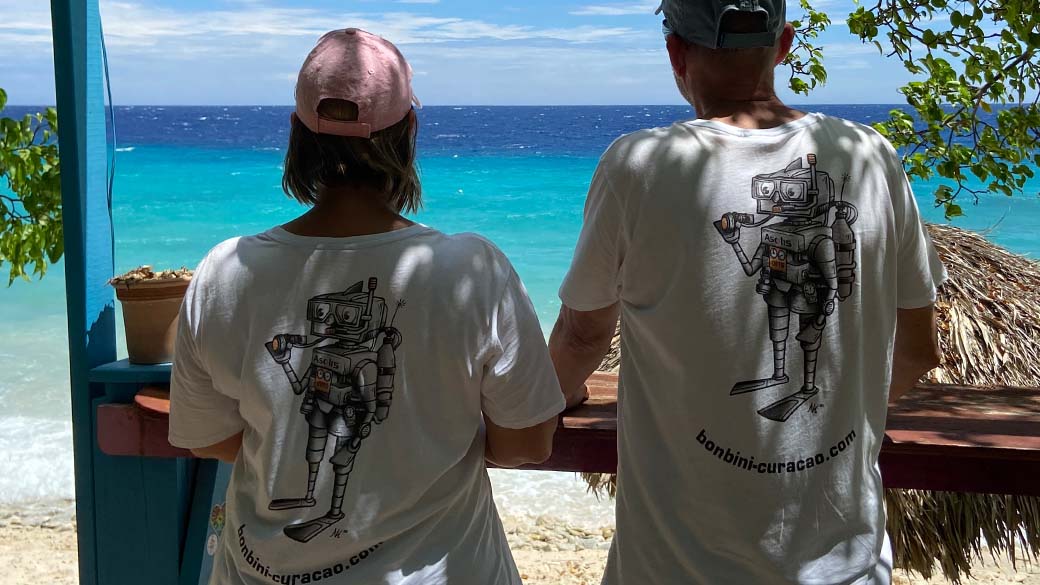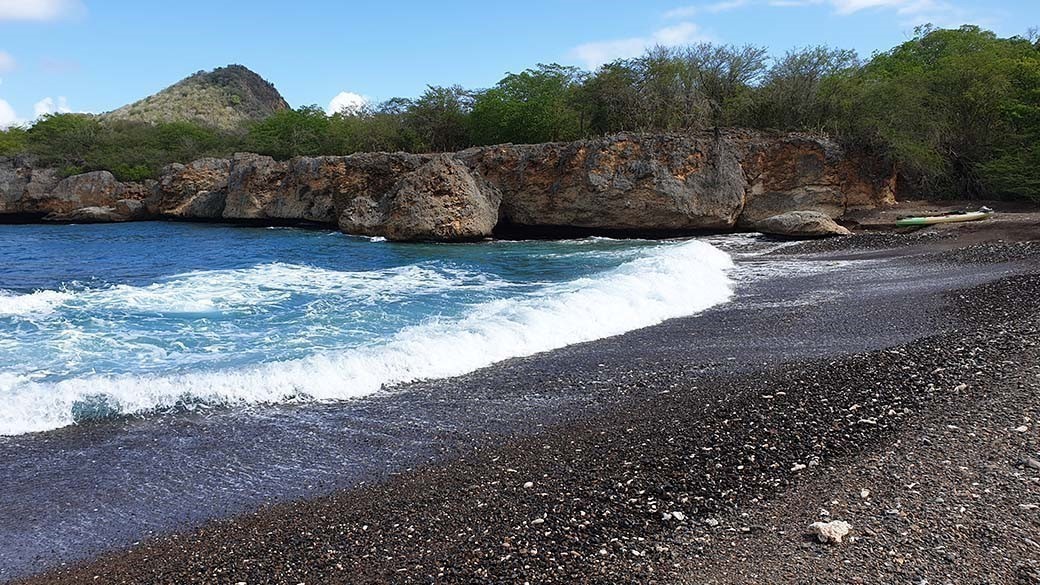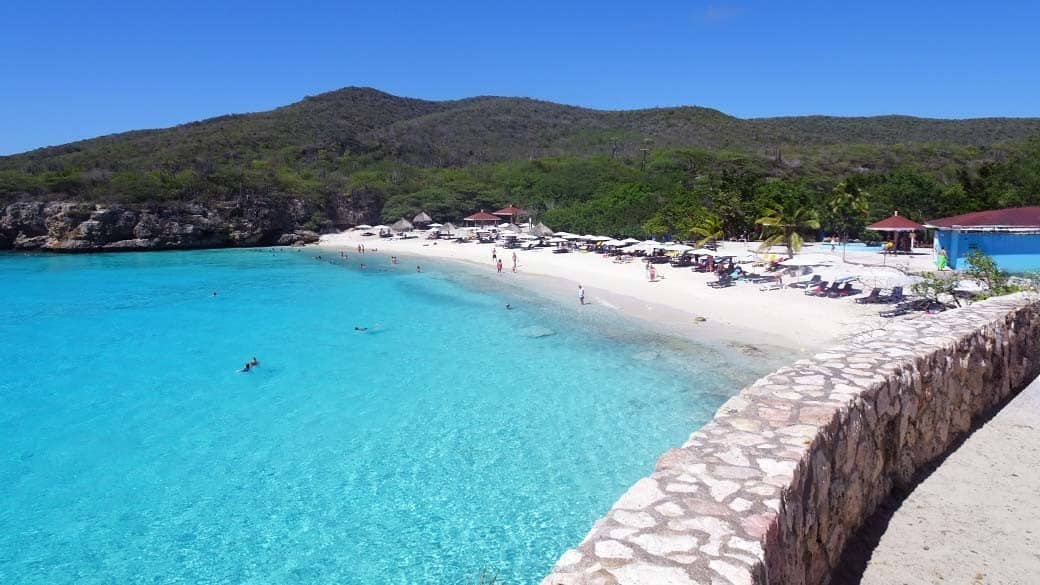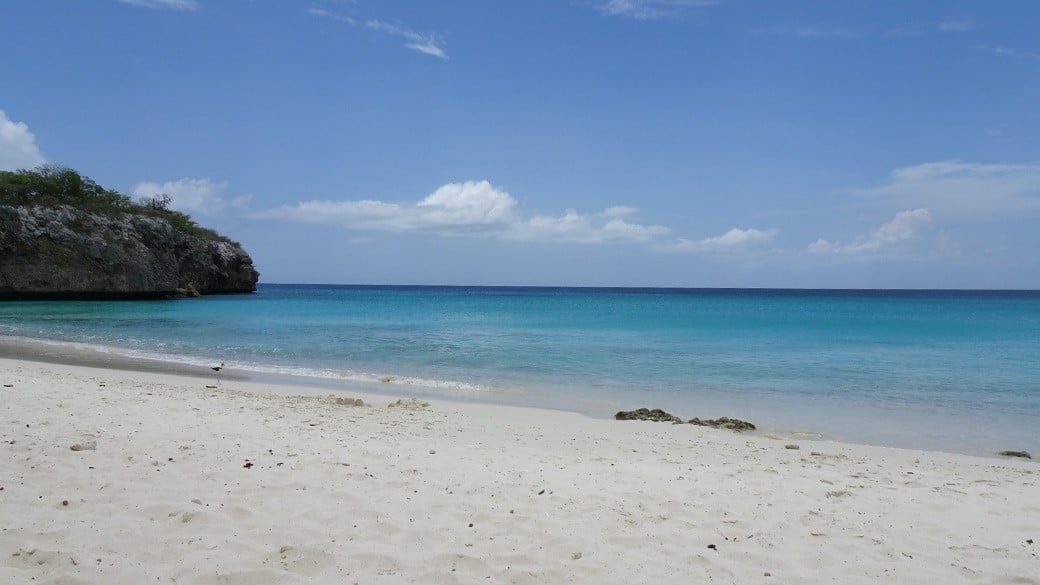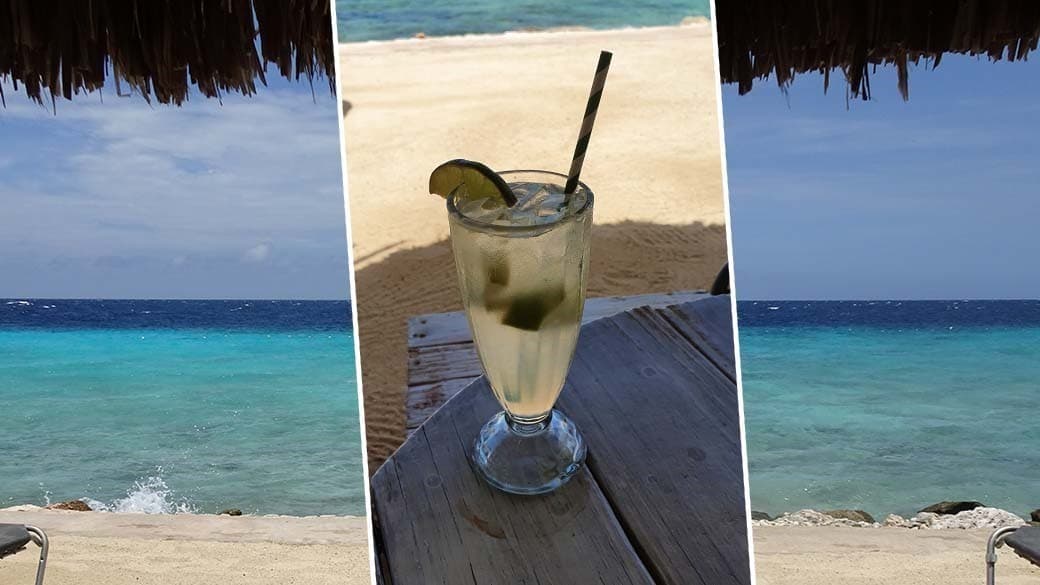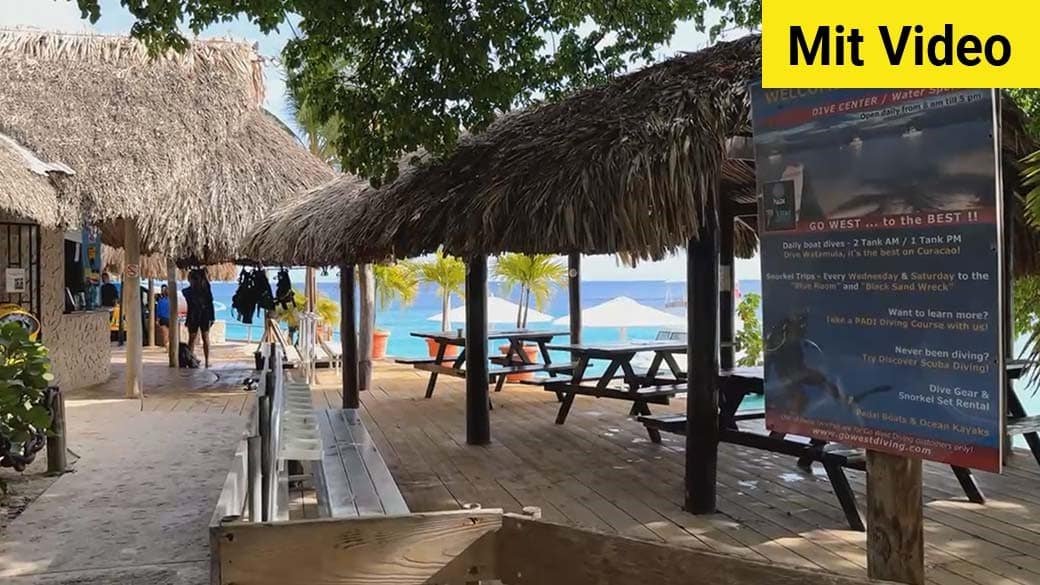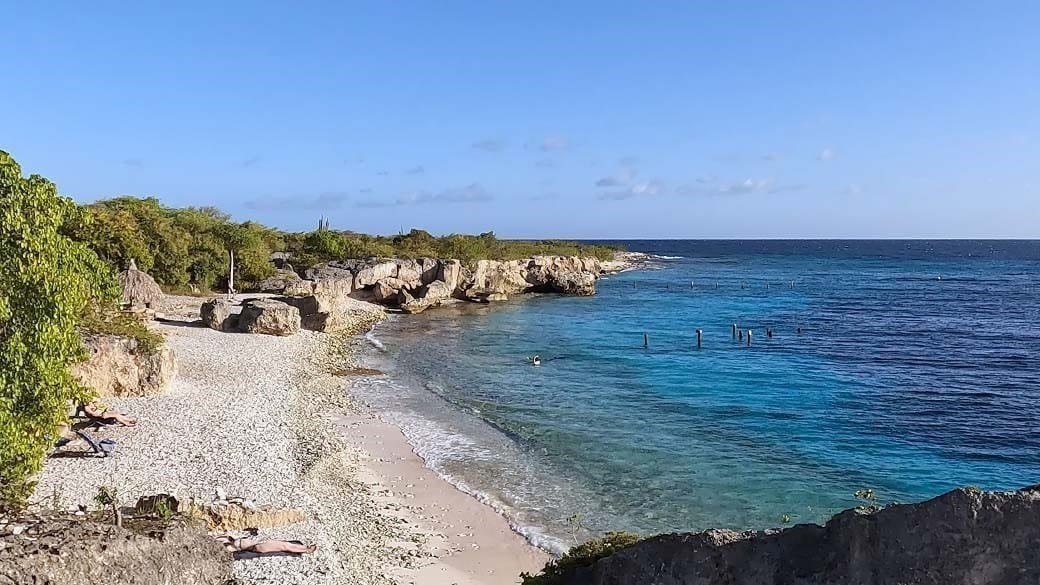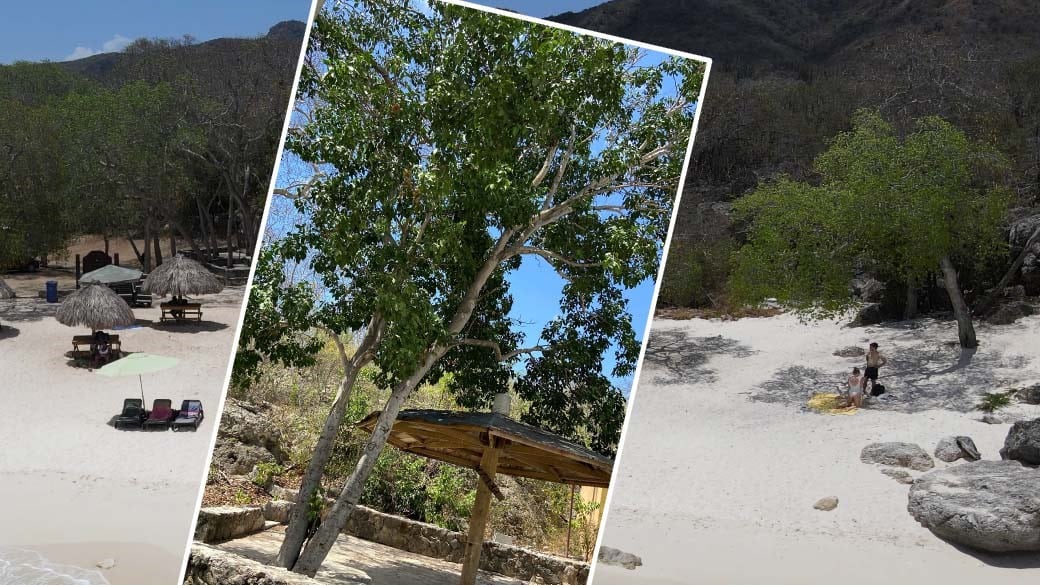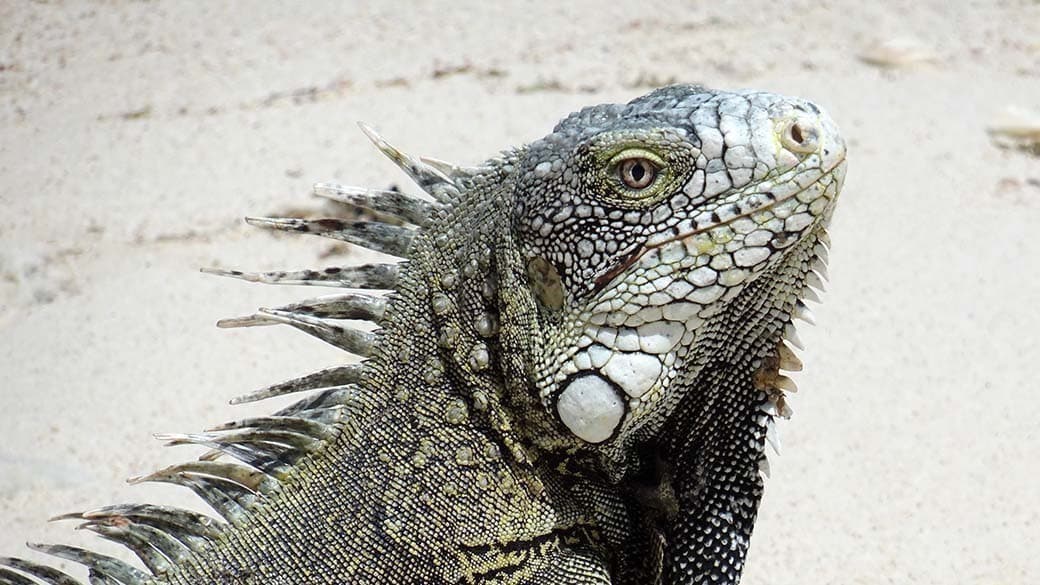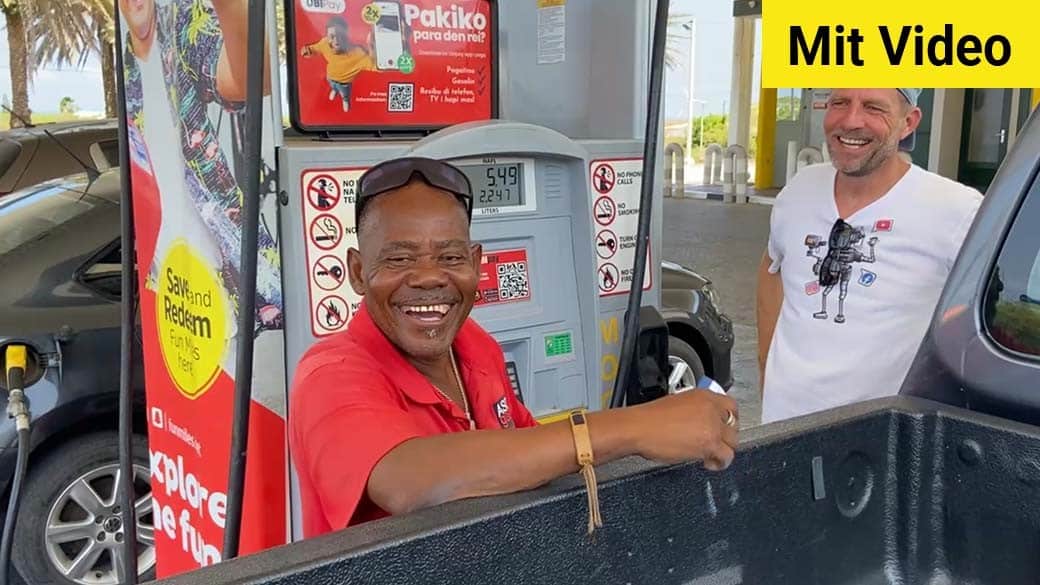Wara Wara
Much fanfare about its call
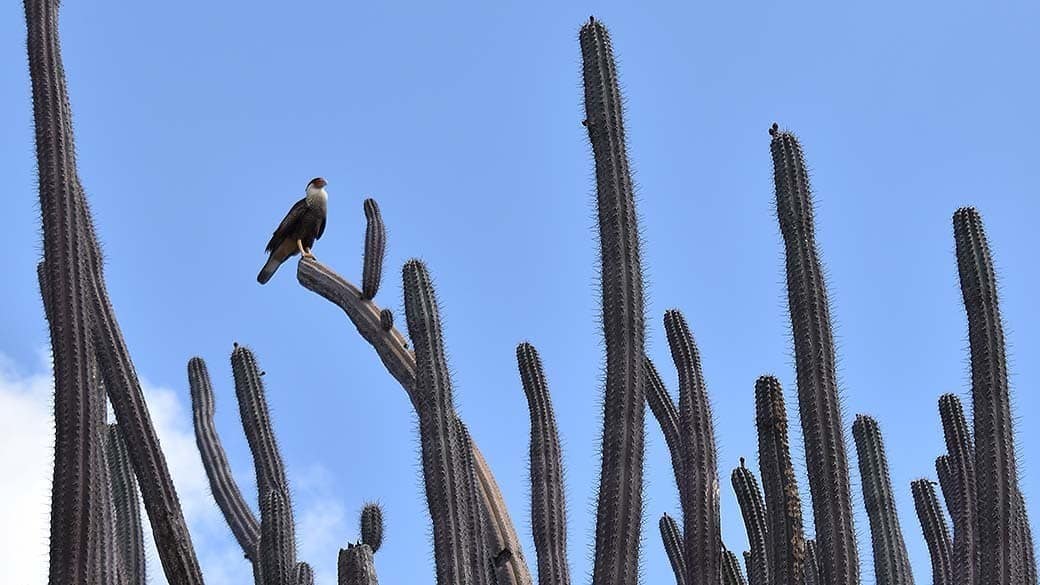
The Wara Wara is a bizarre bird and an interesting contemporary at the same time. It makes funny noises and is quite useful, as you'll see later.
We first encountered Waras Waras a few years ago in Westpunt at the Rancho El Sobrino hotel resort. While we were waiting for our food, our kids came back after exploring the area. They were excited to show us around and told us we should definitely come with them.
A noisy discovery
The kids were really into two big birds of prey they found in an aviary in front of the restaurant facing the street. They were drawn in by the weird sounds these birds made. One was on a perch, the other on the ground, and it was putting on a show: first it rattled strangely, then it accelerated this sound again to a "Brrrrrra." At the same time, it threw its head completely backwards. It kept its eyes fixed on the observers.
The children had never seen or heard birds like this before. They found them so funny that they recorded the whole thing in sound and vision. They played the video over and over again and laughed at these hilarious birds called Wara Wara. We were lucky and so are you, because now you can watch and, more importantly, listen to the Wara Wara on our YouTube channel.
Wara Wara at Rancho El Sobrino – a short story about our birds
This is the headline on a now somewhat weathered sign at the entrance to the hotel. It shows a man with a Wara Wara on his shoulder and tells the story of the two birds that our children filmed.
There were once two Wara Waras that were abandoned by their mother as babies. Without the necessary brood care, their lives were in danger. A local man from Westpunt found the two foundlings and brought them to Randolph Ricardo. He was known locally as an animal lover and was also the owner of Rancho El Sobrino. His rancho used to be a real ranch and a home for animals of all kinds. It was only later that it became the hotel that it is now. Randolph Ricardo took in the two young birds, fed them daily and gave them a new home. After a while he set them free, but they kept returning to their foster father at Rancho El Sobrino. The two Wara Waras weren't used to their natural habitat and hadn't learned to hunt. Therefore, they would probably not have survived in the wild.

Wara Wara from Randolph Ricardo and its story on a sign at Rancho El Sobrino
The sign doesn't say it, but it's clear Randolph took really good care of the animals. The birds had obviously developed a close relationship with him. This is proven by the picture. At least one of them was tame, or the photo with the bird of prey on his shoulder wouldn't have been taken.
The birds were kept in the aviary due to the restaurant's operation. Otherwise, guests would have been amazed at how quickly the Wara Waras ate the food from their plate.
Today, the two birds are no longer on site and the restaurant is now called Cactus Café. Emelin and Taco are your hosts here and we highly recommend you try the legendary Peanut Banana Soup.
About the Wara Wara itself
The common name for Wara Waras is caracara (Caracara plancus). It belongs to the vulture falcon family (Polyborini) and is widespread in Central and South America. On land, it is probably one of the largest birds on Curacao – not counting the ostriches at the ostrich farm.
The Wara Wara can reach a length of over 50 cm and a wingspan of around 120 cm. The males are smaller than the females. From what we could tell, both sexes on Curacao felt somewhat smaller than these figures, but of course we couldn't measure the birds.
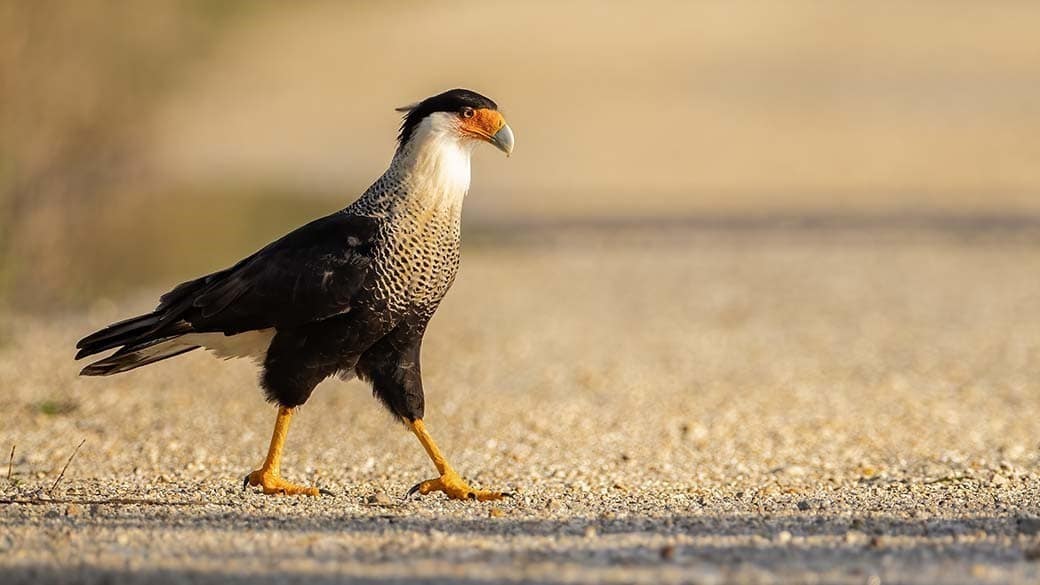
Close-up of an adult Crested Caracara
Other distinguishing characteristics of the bird of prey include a black crown and a white head. Its beak is orange-white, and the rest of the body is banded black-brown. Young birds are typically lighter in color and more striped than banded. Wara Waras typically live for around 30 years.
Who knows why it screams like that
Brehms Tierleben describes the behavior of the Carancho, or Wara Wara, as follows:
"When screaming, the Carancho lays its head completely on its back and croaks "Traaa", then raises it again and calls "Rooo" in a hoarse, croaking voice. This is similar to the creaking that occurs when wood is violently struck or rubbed against wood. This cry can be heard from afar, but it's very unpleasant. (…) The female also screamed loudly and unpleasantly, but only the male threw his head back when screaming."
(Brehm, Alfred E. (1892), Brehms Tierleben. Allgemeine Kunde des Tierreichs, vol. 6, pp. 411-413. Source: http://www.biolib.de/brehm/band6/icon_page_00444.html)
The unique sounds and strange behavior are consistent with what we observed in the rancho. If the head-bobbing display is a characteristic of male birds, then at least one of Randolph's Wara Waras is male.
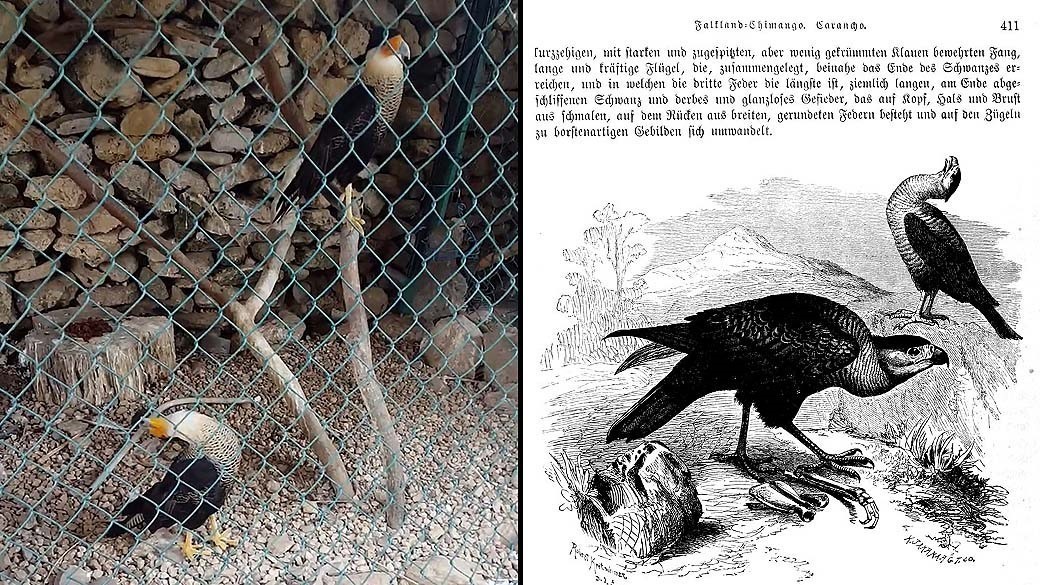
Wara Waras from the rancho compared with an illustration from Brehm's Tierleben 1892 (source: www.BioLib.de)
Natural traffic and aerial surveillance
Wara Waras do not really resemble our falcons, as they are not small, swift hunters. Their long legs, which are also atypical for falcons, allow them to move quite skillfully on foot. They're just as good at carrying away prey with these legs. The birds literally strut across the streets and also spend a lot of time on the ground. You will inevitably come across some as you drive across the island, on the road, on the side of the road, on trees or quite picturesquely on the giant cacti.
The vultures are circling
They're also a majestic sight in the sky. The Caracara's wings make a lot of noise as they flap, and its eyes are sharp and its beak is pointed. It's basically a great hunter and observer. And so it constantly monitors the airspace, the beaches and the streets of Curacao, always on the lookout for something to eat.
Vultures are mostly scavengers, but they'll eat fresh food too. Their prey includes insects, worms, reptiles, amphibians and occasionally small birds and mammals. They know how to raid birds' nests, eat the flesh of coconuts, and they're not always popular because they steal chicken chicks or eat other animals. Wara Waras are smart, and in the wild, they sometimes hunt together to catch larger prey. They also eat dead or dying fish, flotsam and jetsam, and household waste, so they're opportunists.

A young bird on patrol at the roadside
Ranger of the skies
Because Wara Waras, like vultures, like to eat carrion, they often search roads for roadkill. Animal carcasses don't linger for long: the Wara Waras track them down and dispose of them by eating them whole. At temperatures of around 30° Celsius, they are really very useful volunteers – like an additional street cleaning team on the island. Nothing is left lying around… And so the Wara Wara contributes to an intact ecosystem on Curacao by keeping the environment clean.
VIP visitor strokes Wara Wara
In early November 2023, Princess Beatrix, the patron of the Dutch Caribbean Nature Alliance (DCNA), paid a visit to the former Savonet plantation at the foot of Christoffel Mountain. The visit was hosted by CARMABI (Caribbean Research and Management of Biodiversity), represented by Odette Doest, Chair of the Board of the non-profit foundation. CARMABI is a member of the DCNA and currently uses the Savonet Plantation Complex as operations center for the Terrestrial Parks Department.
The former Queen of the Netherlands (until April 2013) got an overview of Curacao's semi-arid ecosystem and its flora and fauna. She met the feathered ranger.
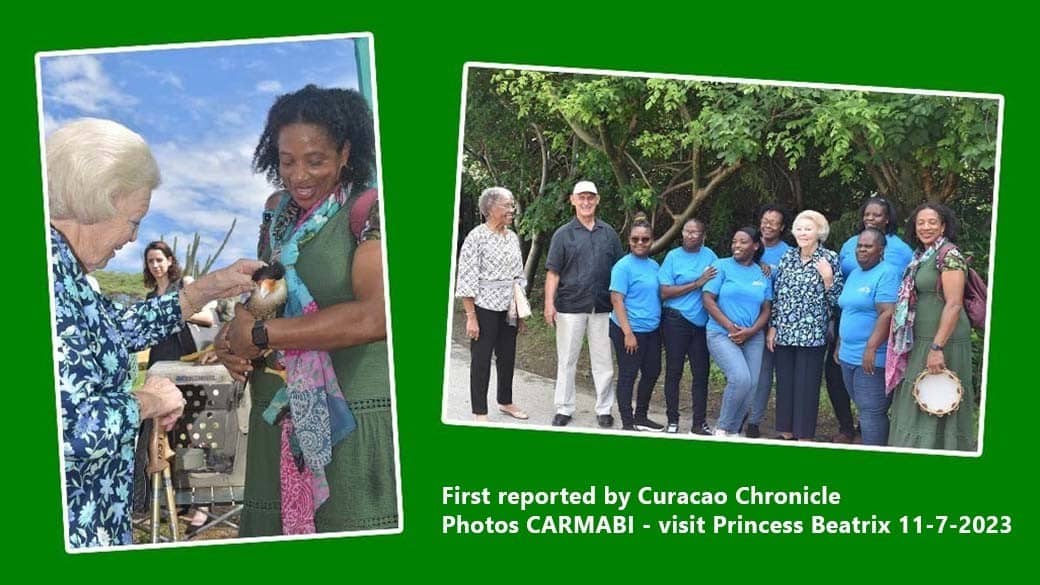
Princess Beatrix and Odette Doest in close contact with our main actor – source: Curacao Chronicle
Do you know the answer? We collected 100+ entertaining questions about Curacao. Have fun!
Quiz Question
What do the beaches Daaibooi, Grote Knip and Porto Mari have in common?Answer
There are pigs on these beaches.
At Daaibooi Beach, they tend to hide in the bushes and can be found in the evening or at night.
Porto Mari is home to the two famous pigs Willy and Woody, who also like to pose for photos during the day and are always on the lookout for something edible.
We met a pink and black spotted pig at the Grote Knip.
Do you like more? Here is another post you might be interested in:
If you enjoyed this article, we would be very happy if you share it with your friends on social media. Thank you very much!
Fancy the sea? In our Beaches and Snorkeling & Diving sections, your vacation dreams will come true. In the Lifestyle section, we tell you about the colorful Caribbean way of life. You'll find culinary delights in Restaurants & Bars and in Shopping we show you where you can find great and affordable deals. Wanna an insider tip? Pssst – click quietly!
Wara Wara
Much fanfare about its call

The Wara Wara is a bizarre bird and an interesting contemporary at the same time. It makes funny noises and is quite useful, as you'll see later.
We first encountered Waras Waras a few years ago in Westpunt at the Rancho El Sobrino hotel resort. While we were waiting for our food, our kids came back after exploring the area. They were excited to show us around and told us we should definitely come with them.
A noisy discovery
The kids were really into two big birds of prey they found in an aviary in front of the restaurant facing the street. They were drawn in by the weird sounds these birds made. One was on a perch, the other on the ground, and it was putting on a show: first it rattled strangely, then it accelerated this sound again to a "Brrrrrra." At the same time, it threw its head completely backwards. It kept its eyes fixed on the observers.
The children had never seen or heard birds like this before. They found them so funny that they recorded the whole thing in sound and vision. They played the video over and over again and laughed at these hilarious birds called Wara Wara. We were lucky and so are you, because now you can watch and, more importantly, listen to the Wara Wara on our YouTube channel.
Wara Wara at Rancho El Sobrino – a short story about our birds
This is the headline on a now somewhat weathered sign at the entrance to the hotel. It shows a man with a Wara Wara on his shoulder and tells the story of the two birds that our children filmed.
There were once two Wara Waras that were abandoned by their mother as babies. Without the necessary brood care, their lives were in danger. A local man from Westpunt found the two foundlings and brought them to Randolph Ricardo. He was known locally as an animal lover and was also the owner of Rancho El Sobrino. His rancho used to be a real ranch and a home for animals of all kinds. It was only later that it became the hotel that it is now. Randolph Ricardo took in the two young birds, fed them daily and gave them a new home. After a while he set them free, but they kept returning to their foster father at Rancho El Sobrino. The two Wara Waras weren't used to their natural habitat and hadn't learned to hunt. Therefore, they would probably not have survived in the wild.

Wara Wara from Randolph Ricardo and its story on a sign at Rancho El Sobrino
The sign doesn't say it, but it's clear Randolph took really good care of the animals. The birds had obviously developed a close relationship with him. This is proven by the picture. At least one of them was tame, or the photo with the bird of prey on his shoulder wouldn't have been taken.
The birds were kept in the aviary due to the restaurant's operation. Otherwise, guests would have been amazed at how quickly the Wara Waras ate the food from their plate.
Today, the two birds are no longer on site and the restaurant is now called Cactus Café. Emelin and Taco are your hosts here and we highly recommend you try the legendary Peanut Banana Soup.
About the Wara Wara itself
The common name for Wara Waras is caracara (Caracara plancus). It belongs to the vulture falcon family (Polyborini) and is widespread in Central and South America. On land, it is probably one of the largest birds on Curacao – not counting the ostriches at the ostrich farm.
The Wara Wara can reach a length of over 50 cm and a wingspan of around 120 cm. The males are smaller than the females. From what we could tell, both sexes on Curacao felt somewhat smaller than these figures, but of course we couldn't measure the birds.

Close-up of an adult Crested Caracara
Other distinguishing characteristics of the bird of prey include a black crown and a white head. Its beak is orange-white, and the rest of the body is banded black-brown. Young birds are typically lighter in color and more striped than banded. Wara Waras typically live for around 30 years.
Who knows why it screams like that
Brehms Tierleben describes the behavior of the Carancho, or Wara Wara, as follows:
"When screaming, the Carancho lays its head completely on its back and croaks "Traaa", then raises it again and calls "Rooo" in a hoarse, croaking voice. This is similar to the creaking that occurs when wood is violently struck or rubbed against wood. This cry can be heard from afar, but it's very unpleasant. (…) The female also screamed loudly and unpleasantly, but only the male threw his head back when screaming."
(Brehm, Alfred E. (1892), Brehms Tierleben. Allgemeine Kunde des Tierreichs, vol. 6, pp. 411-413. Source: http://www.biolib.de/brehm/band6/icon_page_00444.html)
The unique sounds and strange behavior are consistent with what we observed in the rancho. If the head-bobbing display is a characteristic of male birds, then at least one of Randolph's Wara Waras is male.

Wara Waras from the rancho compared with an illustration from Brehm's Tierleben 1892 (source: www.BioLib.de)
Natural traffic and aerial surveillance
Wara Waras do not really resemble our falcons, as they are not small, swift hunters. Their long legs, which are also atypical for falcons, allow them to move quite skillfully on foot. They're just as good at carrying away prey with these legs. The birds literally strut across the streets and also spend a lot of time on the ground. You will inevitably come across some as you drive across the island, on the road, on the side of the road, on trees or quite picturesquely on the giant cacti.
The vultures are circling
They're also a majestic sight in the sky. The Caracara's wings make a lot of noise as they flap, and its eyes are sharp and its beak is pointed. It's basically a great hunter and observer. And so it constantly monitors the airspace, the beaches and the streets of Curacao, always on the lookout for something to eat.
Vultures are mostly scavengers, but they'll eat fresh food too. Their prey includes insects, worms, reptiles, amphibians and occasionally small birds and mammals. They know how to raid birds' nests, eat the flesh of coconuts, and they're not always popular because they steal chicken chicks or eat other animals. Wara Waras are smart, and in the wild, they sometimes hunt together to catch larger prey. They also eat dead or dying fish, flotsam and jetsam, and household waste, so they're opportunists.

A young bird on patrol at the roadside
Ranger of the skies
Because Wara Waras, like vultures, like to eat carrion, they often search roads for roadkill. Animal carcasses don't linger for long: the Wara Waras track them down and dispose of them by eating them whole. At temperatures of around 30° Celsius, they are really very useful volunteers – like an additional street cleaning team on the island. Nothing is left lying around… And so the Wara Wara contributes to an intact ecosystem on Curacao by keeping the environment clean.
VIP visitor strokes Wara Wara
In early November 2023, Princess Beatrix, the patron of the Dutch Caribbean Nature Alliance (DCNA), paid a visit to the former Savonet plantation at the foot of Christoffel Mountain. The visit was hosted by CARMABI (Caribbean Research and Management of Biodiversity), represented by Odette Doest, Chair of the Board of the non-profit foundation. CARMABI is a member of the DCNA and currently uses the Savonet Plantation Complex as operations center for the Terrestrial Parks Department.
The former Queen of the Netherlands (until April 2013) got an overview of Curacao's semi-arid ecosystem and its flora and fauna. She met the feathered ranger.

Princess Beatrix and Odette Doest in close contact with our main actor – source: Curacao Chronicle
Other articles from the "Nature" category that might interest you:
If you enjoyed this article, we would be very happy if you share it with your friends on social media. Thank you very much!
Leave A Comment
Recommended readings from other categories:
Quiz Question
What do the beaches Daaibooi, Grote Knip and Porto Mari have in common?Answer
There are pigs on these beaches.
At Daaibooi Beach, they tend to hide in the bushes and can be found in the evening or at night.
Porto Mari is home to the two famous pigs Willy and Woody, who also like to pose for photos during the day and are always on the lookout for something edible.
We met a pink and black spotted pig at the Grote Knip.
#withus - our articles at your fingertips on a common map - try it!
Wara Wara
Much fanfare about its call

The Wara Wara is a bizarre bird and an interesting contemporary at the same time. It makes funny noises and is quite useful, as you'll see later.
We first encountered Waras Waras a few years ago in Westpunt at the Rancho El Sobrino hotel resort. While we were waiting for our food, our kids came back after exploring the area. They were excited to show us around and told us we should definitely come with them.
A noisy discovery
The kids were really into two big birds of prey they found in an aviary in front of the restaurant facing the street. They were drawn in by the weird sounds these birds made. One was on a perch, the other on the ground, and it was putting on a show: first it rattled strangely, then it accelerated this sound again to a "Brrrrrra." At the same time, it threw its head completely backwards. It kept its eyes fixed on the observers.
The children had never seen or heard birds like this before. They found them so funny that they recorded the whole thing in sound and vision. They played the video over and over again and laughed at these hilarious birds called Wara Wara. We were lucky and so are you, because now you can watch and, more importantly, listen to the Wara Wara on our YouTube channel.
Wara Wara at Rancho El Sobrino – a short story about our birds
This is the headline on a now somewhat weathered sign at the entrance to the hotel. It shows a man with a Wara Wara on his shoulder and tells the story of the two birds that our children filmed.
There were once two Wara Waras that were abandoned by their mother as babies. Without the necessary brood care, their lives were in danger. A local man from Westpunt found the two foundlings and brought them to Randolph Ricardo. He was known locally as an animal lover and was also the owner of Rancho El Sobrino. His rancho used to be a real ranch and a home for animals of all kinds. It was only later that it became the hotel that it is now. Randolph Ricardo took in the two young birds, fed them daily and gave them a new home. After a while he set them free, but they kept returning to their foster father at Rancho El Sobrino. The two Wara Waras weren't used to their natural habitat and hadn't learned to hunt. Therefore, they would probably not have survived in the wild.

Wara Wara from Randolph Ricardo and its story on a sign at Rancho El Sobrino
The sign doesn't say it, but it's clear Randolph took really good care of the animals. The birds had obviously developed a close relationship with him. This is proven by the picture. At least one of them was tame, or the photo with the bird of prey on his shoulder wouldn't have been taken.
The birds were kept in the aviary due to the restaurant's operation. Otherwise, guests would have been amazed at how quickly the Wara Waras ate the food from their plate.
Today, the two birds are no longer on site and the restaurant is now called Cactus Café. Emelin and Taco are your hosts here and we highly recommend you try the legendary Peanut Banana Soup.
About the Wara Wara itself
The common name for Wara Waras is caracara (Caracara plancus). It belongs to the vulture falcon family (Polyborini) and is widespread in Central and South America. On land, it is probably one of the largest birds on Curacao – not counting the ostriches at the ostrich farm.
The Wara Wara can reach a length of over 50 cm and a wingspan of around 120 cm. The males are smaller than the females. From what we could tell, both sexes on Curacao felt somewhat smaller than these figures, but of course we couldn't measure the birds.

Close-up of an adult Crested Caracara
Other distinguishing characteristics of the bird of prey include a black crown and a white head. Its beak is orange-white, and the rest of the body is banded black-brown. Young birds are typically lighter in color and more striped than banded. Wara Waras typically live for around 30 years.
Who knows why it screams like that
Brehms Tierleben describes the behavior of the Carancho, or Wara Wara, as follows:
"When screaming, the Carancho lays its head completely on its back and croaks "Traaa", then raises it again and calls "Rooo" in a hoarse, croaking voice. This is similar to the creaking that occurs when wood is violently struck or rubbed against wood. This cry can be heard from afar, but it's very unpleasant. (…) The female also screamed loudly and unpleasantly, but only the male threw his head back when screaming."
(Brehm, Alfred E. (1892), Brehms Tierleben. Allgemeine Kunde des Tierreichs, vol. 6, pp. 411-413. Source: http://www.biolib.de/brehm/band6/icon_page_00444.html)
The unique sounds and strange behavior are consistent with what we observed in the rancho. If the head-bobbing display is a characteristic of male birds, then at least one of Randolph's Wara Waras is male.

Wara Waras from the rancho compared with an illustration from Brehm's Tierleben 1892 (source: www.BioLib.de)
Natural traffic and aerial surveillance
Wara Waras do not really resemble our falcons, as they are not small, swift hunters. Their long legs, which are also atypical for falcons, allow them to move quite skillfully on foot. They're just as good at carrying away prey with these legs. The birds literally strut across the streets and also spend a lot of time on the ground. You will inevitably come across some as you drive across the island, on the road, on the side of the road, on trees or quite picturesquely on the giant cacti.
The vultures are circling
They're also a majestic sight in the sky. The Caracara's wings make a lot of noise as they flap, and its eyes are sharp and its beak is pointed. It's basically a great hunter and observer. And so it constantly monitors the airspace, the beaches and the streets of Curacao, always on the lookout for something to eat.
Vultures are mostly scavengers, but they'll eat fresh food too. Their prey includes insects, worms, reptiles, amphibians and occasionally small birds and mammals. They know how to raid birds' nests, eat the flesh of coconuts, and they're not always popular because they steal chicken chicks or eat other animals. Wara Waras are smart, and in the wild, they sometimes hunt together to catch larger prey. They also eat dead or dying fish, flotsam and jetsam, and household waste, so they're opportunists.

A young bird on patrol at the roadside
Ranger of the skies
Because Wara Waras, like vultures, like to eat carrion, they often search roads for roadkill. Animal carcasses don't linger for long: the Wara Waras track them down and dispose of them by eating them whole. At temperatures of around 30° Celsius, they are really very useful volunteers – like an additional street cleaning team on the island. Nothing is left lying around… And so the Wara Wara contributes to an intact ecosystem on Curacao by keeping the environment clean.
VIP visitor strokes Wara Wara
In early November 2023, Princess Beatrix, the patron of the Dutch Caribbean Nature Alliance (DCNA), paid a visit to the former Savonet plantation at the foot of Christoffel Mountain. The visit was hosted by CARMABI (Caribbean Research and Management of Biodiversity), represented by Odette Doest, Chair of the Board of the non-profit foundation. CARMABI is a member of the DCNA and currently uses the Savonet Plantation Complex as operations center for the Terrestrial Parks Department.
The former Queen of the Netherlands (until April 2013) got an overview of Curacao's semi-arid ecosystem and its flora and fauna. She met the feathered ranger.

Princess Beatrix and Odette Doest in close contact with our main actor – source: Curacao Chronicle
Other articles you might find interesting:
Curacao is alive and things are always changing. What has changed since our last visit? How is your experience? Would you please share your personal experiences with us? Feel free to write your comment under this article and follow us on our social media channels. There you can spontaneously share your personal impressions with us and our community - "sharing is caring". We look forward to your contribution and every new follower!
Leave A Comment
Quiz Question
What do the beaches Daaibooi, Grote Knip and Porto Mari have in common?Answer
There are pigs on these beaches.
At Daaibooi Beach, they tend to hide in the bushes and can be found in the evening or at night.
Porto Mari is home to the two famous pigs Willy and Woody, who also like to pose for photos during the day and are always on the lookout for something edible.
We met a pink and black spotted pig at the Grote Knip.
#withus - our articles at your fingertips on a common map - try it!



